 полная версия
полная версияStories of Useful Inventions
If primitive man were slow to learn the use of iron it was not because this metal was scarce, for iron is everywhere. "Wherever, as we go up and down, we see a red-colored surface, or a reddish tint upon the solid substances of the earth, we see iron – the bank of red clay, the red brick, the red paint upon the house wall, the complexion of rosy youth, or my lady's ribbon. Even the rosy apple derives its tint from iron which it contains."8 But although iron is so abundant it is seldom found in its pure or natural state. It is nearly always mixed with other substances, the mixture being known as iron ore. Primitive man could find copper and tin in their pure state but the only pure iron he could find was the little which fell from heaven in the form of meteors, and even this was not perfectly pure for meteoric iron is also mixed slightly with other metals.
The iron which lay about primitive man in such abundance was buried and locked tightly in an ore. To separate the iron from the other substances of the ore was by no means an easy thing to do. Iron can best be extracted from the ore by putting the ore in a fire and melting out the iron. Place some iron ore in a fire and if the fire is hot enough – and it must be very hot indeed – the iron will leave the ore and will gather into a lump at the bottom of the fire. To separate the iron from its ore in this way is to make iron. When and where man first learned the secret of making iron is of course unknown. A camp-fire in some part of the world may have shown to man the first lump of iron, or a forest fire sweeping along and melting ores in its path may have given the first hint for the manufacture of iron.
Iron making at first doubtless consisted in simply melting the ore in an open heap of burning wood or charcoal, for charcoal is an excellent fuel for smelting (melting) ores. But this open-fire method was wasteful and tedious and at a very early date the smelting of the ore was done in a rude sort of a furnace. A hole ten or twelve feet deep was dug in the side of a hill. In the hole were placed charcoal and iron ore, first a layer of charcoal, then a layer of the ore. At the top of the mass there was an opening and at the bottom there were several openings. When the mass was set on fire the openings produced a good strong draft, the charcoal was consumed, and the ore was smelted. The product was a lump of wrought iron, known as the bloom.
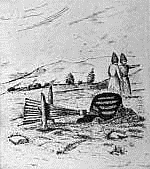
FIG. 3. – THE PRIMITIVE FORGE.

FIG. 4. – BELLOWS WORKED BY THE FEET.
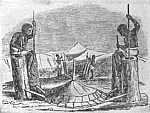
FIG. 5. – THE WOODEN BELLOWS.
The hillside furnace worked well enough when the wind was favorable, but when the wind was unfavorable there was no draft and no iron could be made. So ironmakers found a way by which the air could be driven into the furnace by artificial means. They invented the bellows, a blowing apparatus (Fig. 3) which was usually made of goat skins sewed together and which was operated either by the hands or by the feet (Fig. 4). Sometimes the bellows consisted of a hollow log in which a piston was worked up and down (Fig. 5). After the invention of the bellows, ironmakers could make their iron whenever and wherever they pleased, for they could force air into their furnaces at any time and at any place. This rude bellows forcing a draft of air into a half-closed furnace filled with a burning mass of charcoal and iron ore was the first form of the forge, one of the greatest of all inventions.
With the invention of the forge the stone age gradually passed away and the iron age was ushered in. Tools and weapons could now be made of iron. And great was the difference between iron tools and stone tools. To cut down a tree with a flint hatchet required the labor of a man for a month, while to clear a forest with such an implement was an impossible task. But the forge gave to man iron for the sharp cutting tools, for the ax and knife and chisel and saw. With these he became the master of wood and he could now easily cut down trees and build houses and make furniture and wagons and boats.
As time went on and man advanced in civilization, iron was found to be the most useful of metals. Iron can be shaped into many forms. It can be drawn into wire of any desired length or fineness, it may be bent in any direction, it may be sharpened, or hardened, or softened, at pleasure. "Iron accommodates itself to all our wants and desires and even to our caprices. It is equally serviceable to the arts, the sciences, to agriculture and war; the same ore furnishes the sword, the plowshare, the scythe, the pruning-hook, the needle, the spring of a watch or of a carriage, the chisel, the chain, the anchor, the compass and the bomb. It is a medicine of much virtue and the only metal friendly to the human frame."9
A metal that was so useful was needed in large quantities, yet the primitive forge could turn out only small quantities of iron. A day's labor at the bellows would produce a lump weighing only fifteen or twenty pounds. As a result of this slowness in manufacture there was always in primitive and ancient times a scarcity of iron. Indeed in some countries iron was a precious metal, almost as precious as silver or gold. In many countries, it is true, there were thousands of forges at work, but in no country was the supply of iron equal to the demand. The old forge could not supply the demand, yet centuries passed before any great improvement was made in the progress of iron making.
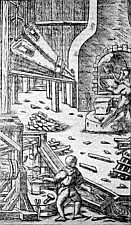
FIG. 6. – A BLAST FURNACE OF THE MIDDLE AGES.
Near the close of the Middle Ages improvements upon the primitive forge began to be made. In the sixteenth century ironmakers in Germany began to smelt ore in closed furnaces and to build their furnaces higher and to make them larger (Fig. 6). Sometimes they built their furnaces to a height of twenty or thirty feet. About this time also a better and a stronger blast was invented. Water-power instead of hand-power began to be used for operating the bellows. In some cases wooden bellows – great wooden pistons working in tubs – were substituted for the old bellows of leather. By the end of the sixteenth century so many improvements had been made upon the primitive forge that it no longer resembled the forge of ancient times. So the new forge received a new name and was called a blast furnace.10 You should observe, however, that the blast furnace was simply the old forge built with a large closed furnace and provided with a more powerful blast.
The invention of the blast furnace marked the beginning of a new era in the history of iron making. In the first place there was produced in the blast furnace a kind of iron that was entirely different from that which was produced in the primitive forge. In the primitive forge there was made a lump of practically pure unmelted iron, known as wrought iron. In the blast furnace there was produced a somewhat impure grade of melted iron, known as cast iron, or pig11 iron. In the second place, the blast furnace produced iron in quantities vastly greater than it was ever produced by the old forge. In the blast furnace more iron could be made in a day than could be made by the forge in a month. In some of the early blast furnaces a thousand pounds of iron could be made at one melting and we read of one early furnace that produced 150 tons of iron in a year.
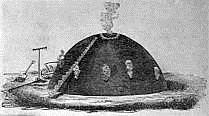
FIG. 7. – MAKING CHARCOAL.
But even with the blast furnace it was still difficult to make enough iron to supply the ever-increasing demands of the industrial world. In the sixteenth and seventeenth centuries machinery was brought into use more than ever before and of course more iron was needed for the construction of the machines. There was ore enough for all the iron that was needed but it was difficult to get fuel enough to smelt the ore. Charcoal was still used as the fuel for smelting (Fig. 7), and in order to get wood for the charcoal great inroads were made upon the forests. In England in the early part of the eighteenth century Parliament had to put a check upon the manufacture of iron in certain counties in order to save the forests of those counties from utter destruction. It then became plain that if iron making were to be continued on a large scale a new kind of fuel would have to be used in the furnaces. So men set their wits to work to find a new kind of fuel. As far back as 1619 Dud Dudley in the county of Warwick, England, undertook to use ordinary soft coal in his furnaces but his experiment was not very successful or very profitable. More than a century after this an English ironmaker named Abraham Darby began (in 1735) to use charred coal in his blast furnaces, and his experiments were successful. Here was the new fuel which was so badly needed. Charred coal is simply coke and coke could be had in abundance. So the new fuel was soon used in all parts of England and by the end of the eighteenth century coke was driving charcoal out of blast furnaces (Fig. 8).
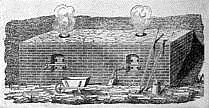
FIG. 8. – A PITTSBURGH COKE OVEN.
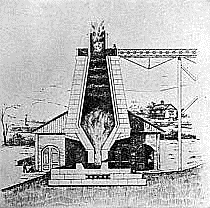
FIG. 9. – A MODERN BLAST FURNACE.
About the time the use of coke for smelting became general, an Englishman named Neilson brought about another great change in the process of iron making. Before Neilson's time the blast driven into the furnace had always been one of cold air. Neilson learned that if the air before entering the furnace were heated to a temperature of 600 degrees it would melt twice the amount of ore and thus produce twice the amount of iron without any increase in the amount of fuel. So he invented (in 1828) a hot blast for the blast furnace (Fig. 9). With the use of coke and with the hot blast the production of iron increased enormously. But there was need for all the iron that could be made. Indeed it seems that the world can never get too much iron. About the time the hot blast was invented iron chains instead of ropes began to be used for holding anchors, iron plows began to be made in great numbers (p. 83), iron pipes instead of hollow wooden logs began to be used as water-mains in cities, and iron rails began to be used on railroads. To supply iron for all these purposes kept ironmakers busy enough, even though they burned coke in their furnaces and made use of the hot air blast.
But ironmakers were soon to become busier than ever before. About the middle of the nineteenth century Sir Henry Bessemer invented a new process of making steel. Steel is only iron mixed with a small amount of carbon. Ironmakers have known how to make steel – and good steel, too – for thousands of years, but before the days of Bessemer the process had always been slow and tedious, and the cost of steel had always been very great. Bessemer undertook to make steel in large quantities and at low prices. In his experiments amid showers of molten metal he often risked his life, but his perseverance and courage were rewarded. By 1858 he had invented a process by which tons of molten iron could be run into a furnace and in a few minutes be converted into a fine quality of steel. This invention of Bessemer was the last great step in the history of the forge.
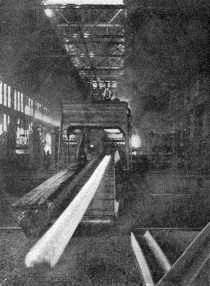
From copyright stereograph by Underwood & Underwood, N. Y.
FIG. 10. – GREAT STEEL RAIL PASSING THROUGH ROLLER STEEL MILL.
Now that steel could be made in great quantities and at a low cost it was put to uses never dreamed of in former times. Soon the railroad rail was made of steel (Fig. 10), bridges were made of steel, ships of war were plated with steel. Then ocean grayhounds and battleships were made of steel, still later steel freight cars and steel passenger coaches were introduced, while in our own time we see vast quantities of steel used in the building of houses. So while the invention of Bessemer marked the last step in the history of the forge it also marked the ending of the Age of Iron and the beginning of the wonderful age in which we live – the Age of Steel.
THE STEAM-ENGINE
We have now traced the steps by which man mastered the art of kindling a fire quickly and easily and have followed the progress that has been made in the most common uses of fire. But the story of a most important use of fire remains to be told, the story of its use in doing man's work. How important this use is, how much of the world's work is done through the agency of fire, a little reflection will make plain. Fire makes steam and what does steam do? Its services are so many you could hardly name all of them. The great and many services of steam are made possible by the fire-engine, or steam-engine, and the story of this wonderful invention will now be told.
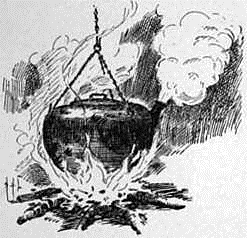
FIG. 1. – FIRST EXPERIMENTS WITH STEAM.
That steam has the power to move things must have been learned almost as soon as fire was used to boil water. Heat water until it boils and the steam that is formed is bound to move something unless it is allowed to escape freely. It will burst the vessel if an outlet is not provided. That is why a spout has been placed on the tea-kettle. Where there is cooking, steam is abundant and the first experiments in steam were doubtless made in the kitchen (Fig. 1). It has been said that the idea of the steam-engine first occurred to Adam as he watched his wife's kettle boil.
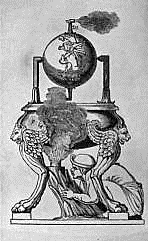
FIG. 2. – HERO'S ENGINE, 120 B. C.
Whatever may have happened in ancient kitchens, we are certain that there were no steam-engines until many centuries after Adam. The beginnings of this invention are not shrouded in so much mystery as are those of the match and the lamp and the forge. In giving an account of the steam-engine we can mention names and give dates from the very beginning of the story. We know what the first steam-engine was like and we know who made it and when and where it was made. It was made 120 B. C. by Hero, a philosopher of Alexandria in Egypt. It was like the one shown in Figure 2. The boy applies the fire to the steam-tight vessel p and when steam is formed it passes up through the tube o and enters the globe which turns easily on the pivots. The steam, when it has filled the globe, rushes out of the short tubes w and z projecting from opposite sides of the globe and bent at the end in opposite directions. As it rushes out of the tubes the steam strikes against the air and the reaction causes the globe to revolve, just as in yards we sometimes see jets of water causing bent tubes to revolve. This was Hero's engine, the first steam-engine ever made.
Hero's engine was used only as a toy and it seems to represent all the ancients knew about the power of steam and all they did with it. It is not strange that they did not know more for there is no general rule by which discoveries are made. Sometimes even enlightened peoples have for centuries remained blind to the simplest principles of nature. The Greeks and Romans with all their culture and wisdom were ignorant of some of the plainest facts of science. It is a little strange, however, that after Hero's discovery was made known, men did not profit by it. It would seem that eager and persistent attempts would have been made at once to have steam do useful work, as well as furnish amusement. But such was not the case. Hero's countrymen paid but little attention to his invention and the steam-engine passed almost completely out of men's minds and did not again attract attention for nearly seventeen hundred years.

FIG. 3. – BRANCA'S ENGINE, 1629.
About the end of the fifteenth century Europe began to awaken from a long slumber and by the end of the sixteenth century its eyes were wide open. Everywhere men were now trying to learn all they could. The study of steam was taken up in earnest about the middle of the sixteenth century and by the middle of the next century quite a little had been learned of its nature and power. In 1629 an Italian, Branca by name, described in a book a steam-engine which would furnish power for pounding drugs in a mortar. There was no more need for such a machine then than there is now and of course the inventor aroused no interest in his engine. You can easily understand how Branca's engine (Fig. 3) works. The steam causes the wheels and the cylinder to revolve. As the cylinder revolves, a cleat on it catches a cleat on the pestle and lifts the pestle a short distance and then lets it fall. Here the pestle instead of being raised by a human hand is raised by the force of steam. This engine would be more interesting if an engine had actually been made, but there is no reason to believe that Branca ever made the engine he described. We owe much to him, nevertheless, for suggesting how steam might be put to doing useful work.
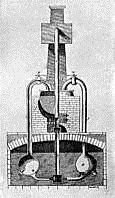
FIG. 4. – WORCESTER'S ENGINE, 1663.
It was not very long before an Englishman put into practice what the Italian had only suggested. Edward Somerset, the Second Marquis of Worcester, in 1663 built a steam-engine that raised to the height of forty feet four large buckets of water in four minutes of time. This was the first useful work ever done by steam. Figure 4 shows the construction of Worcester's engine.
In this engine there was one improvement over former engines which was of the greatest importance: there was one vessel in which the steam was generated and another in which the steam did its work. The steam-engine now consisted of two great divisions, the boiler and the engine proper.
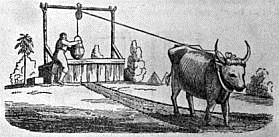
FIG. 5. – AN ANCIENT METHOD OF DRAWING WATER.
Worcester spent a large part of his fortune in trying to improve the steam-engine, yet he received neither profit nor honor as a reward. He died poor and his name was soon forgotten. His service to the world was nevertheless very great. In his time the mines of England had been sunk very deep into the earth; and the deeper they were sunk the greater was the difficulty of lifting the water out of them and keeping them dry. The water was lifted up from the mines by means of buckets drawn by horses or oxen (Fig. 5). Sometimes it took several hundred horses to keep the water out of a single mine. It was Worcester's object to construct an engine that would do the work of the horses. The engine he built could not do this, yet it furnished the idea – and the idea is often the most important thing. It was not long before engines built upon Worcester's plan were doing useful work at the mines. At the opening of the eighteenth century the steam-engine had been put to work and was serving man in England and throughout the continent of Europe.

FIG. 6. – PAPIN'S ENGINE, 1690.
The first engines were not safe. Often the steam pressed too heavily upon the sides of the vessel in which it was compressed and there were explosions. About 1680 Denis Papin, a Frenchman, invented the safety valve, that is a valve that opens of its own accord and lets out steam when there is more in the vessel than ought to be there. About ten years later Papin gave the world another most valuable idea. In Worcester's engine the steam in the steam chest pressed directly on the water that was to be forced up. Papin showed a better way. He invented the engine shown in Figure 6. In this engine a small quantity of water was placed in the bottom of the cylinder A. Fitting closely in the cylinder was a piston B such as Papin had seen used in ordinary pumps. We will suppose that the piston is near the bottom of the cylinder and that a fire is built underneath. The bottom being made of very thin metal the water is rapidly converted into steam and thus drives the piston up to the top as shown in the figure. Here a latch E catches the piston-rod H and holds the piston up until it is time for it to descend. Now the fire is removed and the steam, becoming cold, is condensed and a vacuum is formed below the piston. The latch E now releases the rod H and the piston is driven down by the air above it, pulling with it the rope L which passes over the pulleys TT. As the rope descends it lifts a weight W or does other useful work. As the inventor of the piston Papin ranks among the greatest of those whose names are connected with the development of the steam-engine.
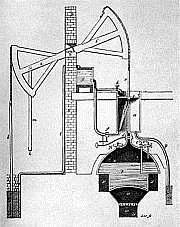
FIG. 7. – NEWCOMEN'S ENGINE, 1705.
Our story has now brought us to the early part of the eighteenth century. Everywhere men were now trying to make the most of the ideas of Worcester and Papin. The mines were growing very deep. As the water in them was getting beyond control something extraordinary had to be done. Now it seems that whenever the world is in need of an extraordinary service someone is found to render that service. The man who built the engine that was needed was a humble blacksmith of Dartmouth, England, Thomas Newcomen. This master mechanic in 1705 constructed the best steam-engine the world had yet seen. We must study Newcomen's engine (Fig. 7) very carefully. The large beam ii moved freely up and down on the pivot v. One end of the beam was connected with the heavy pump-rod k by means of a rope or chain working in a groove and the other end was connected with the rod r in the same way. When steam from the boiler b passed through the valve d into the cylinder (steam-chest) a it raised the piston s and with it the piston-rod r thus slackening the rope and allowing the opposite end of the beam to be pulled down by the weight of the pump-rod k. As soon as the piston s reached the top of the cylinder the steam was shut off by means of the valve d and the valve f was turned and a jet of cold water from the tank g was injected into the cylinder a with the steam. The jet of cold water condensed the steam rapidly – steam is always condensed rapidly when anything cold comes in contact with it – and the water formed by the condensation escaped through the pipe p into the tank o. As soon as the steam in a is condensed, a vacuum was formed in the cylinder and the atmosphere above forced the piston down and at the same time pulled the pump-rod k up and lifted water from the well or mine. When the piston reached the bottom of the cylinder the valve d was opened and the piston again ascended. Thus the beam is made to go up and down and the pumping goes on. Notice that steam pushes the piston one way and the atmosphere pushes it back.
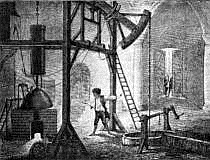
FIG. 8. – HUMPHREY POTTER'S LATCHES AND STRINGS.
In Newcomen's engine the valves (f and d) at first were opened and shut (at each stroke of the piston) by an attendant, usually a boy. In 1713 a boy named Humphrey Potter, in order to get some time for play, by means of strings and latches, caused the beam in its motion to open and shut the valves without human aid. We must not despise Humphrey because his purpose was to gain time for play. The purpose of almost all inventions is to save human labor so that men may have more time for amusement and rest. Humphrey Potter ought to be remembered not as a lazy boy but as a great inventor. His strings and latches improved the engine wonderfully (Fig. 8). Before his invention the piston made only six or eight strokes a minute; after the valves were made to open and shut by the motion of the beam, it made fifteen or sixteen strokes a minute and the engine did more than twice as much work.

